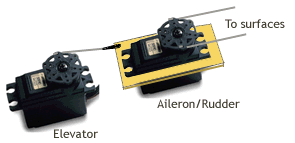V-Tails and Elevons
 V-Tail aircraft are planes that have only two rear stabilization surfaces, in the shape of a 'V',
instead of a conventional horizontal and vertical stabilizers.
V-Tail aircraft are planes that have only two rear stabilization surfaces, in the shape of a 'V',
instead of a conventional horizontal and vertical stabilizers.
In a V-Tail aircraft, the two control surfaces of the V-Tail work together to give both elevator and rudder response. For elevator control, both moving surfaces move up and down in the same direction. For rudder both surfaces move in opposite directions, i.e. right rudder moves the left surface of the V-Tail up and the right surface down. For both elevator and rudder to be used at the same time, both these movements need to be 'mixed' together to get a proper response out of the aircraft.
 For flying wings, the same kind of movement is needed if the wing shares aileron and elevator control surfaces. These surfaces are known as 'Elevons',
but perform basically the same function as v-tails described above.
For flying wings, the same kind of movement is needed if the wing shares aileron and elevator control surfaces. These surfaces are known as 'Elevons',
but perform basically the same function as v-tails described above.
To get the appropriate movement out of the surfaces of a V-Tail or elevon plane, such as a Zagi-5C flying wing, the elevator-rudder or elevator-aileron controls are mixed together with either a mechanical, electronic servo mixer, or a common function now built into most modern transmitters.
Mixers
In the 'old' days (pre-1980 or so), mixing was accomplished via a mechanical fashion. For elevons, it was common to see a linkage
known as a 'sliding servo' mechanism. This is where the v-tail or elevon surfaces were connected to the aileron servo arms and an elevator servo arm was connected to the
aileron servo itself.  The aileron servo moved the elevons like a normal aileron linkage, but the elevator also could pull or push the ailerons up or down
by physically moving the aileron servo. That servo 'slid' on a tray that had been built to hold the servo. See the diagram on the right for a visual picture of this. This could also be done for V-Tail as well.
The aileron servo moved the elevons like a normal aileron linkage, but the elevator also could pull or push the ailerons up or down
by physically moving the aileron servo. That servo 'slid' on a tray that had been built to hold the servo. See the diagram on the right for a visual picture of this. This could also be done for V-Tail as well.
There were also little plastic, mechanical mixers (available from Du-Bro and other manufacturers) [I have several of 'em somewhere] that you'd put between the servos and the tail surfaces or elevons. They accomplished what the sliding servo tray also did, but at the penalty of less surface movement (throw) and the mixers tended to be a bit 'sloppy' or inaccurate at times.
These days, mixing can be accomplished right at the transmitter, so that when the elevator stick was moved, two (or more servos) move accordingly, etc. The radio doesn't always need to be a computer radio either. Some of the middle level non-computer radio systems have built-in V-Tail or Elevon options just by turning on a switch. There are also small little electronic devices that you can buy that cost about the price of a servo that are small and light and will do the mixing right in the plane. Instead of mixing the output of the servos, you plug the servos into this little electronic gadget.
There's a long standing 'belief' about sizing a V-Tail using the 'projected area' of a conventional tail. This has really proved to be a rather inadequate way to compute the correct size needed for a V-Tail sailplane.
For the most part, for an equivalent control 'authority', a conventional, T, or V-Tail should all have the same TOTAL area. This is because of the need to be able to use full rudder and full elevator at the same time. If you make a V-Tail with the same PROJECTED area as your supposedly equivalent conventional tail, you will be able to make the same elevator force, or the same rudder force, but not both at the same time. For certain maneuvers (such as recovery from a spin), this difference can be very significant.
This rule refers to control authority, i.e. how much correcting force the tail can make about the pitch axis and yaw axis. The calculation for equivalent stability is a little more complex, because the apparent change in angle of attack to a given disturbance for the V and conventional tails are not the same.
The effective area of a V-Tail for pitch stability is equal to the total area times the cosine squared of the tail's dihedral angle. If you make the total area the same as the original conventional tail, you will be in the ballpark with a working V-Tail.
Some have reported that their models seemed to be more maneuverable using the projected area method for making their substitute V-tails. This makes perfect sense; in general, when you reduce stability (in this case because the "projected area" tail is smaller than the original tail) you generally increase maneuverability. The model has less damping about the pitch and yaw axes, so it takes less to disturb its flight path in those directions. Nothing wrong with any of this, just recognize that you have just re-engineered the basic design of your model by reducing the area of the tail, in addition to the change in tail configuration. Depending on how much surplus tail the model had to begin with, the results may or may not be satisfactory.
If you have some stories or other comments that you'd like to share with others about this subject, please write me mail and I'll be glad to post it.
